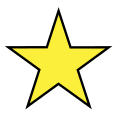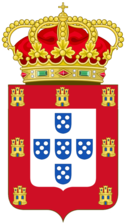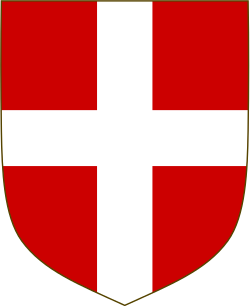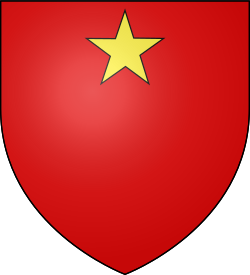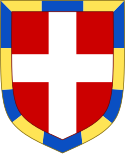Beizeichen
Beizeichen (Bruch, franz. Brisure) sind Zeichen in den Wappen, welche zur Unterscheidung abgeteilter Linien oder zur Kennzeichnung jüngerer Geburt oder unehelicher Abkunft (Letzteres nur bei westlichen Nationen) dienen können.
Grundlagen
In Westeuropa wurden Beizeichen häufiger verwendet als in Mitteleuropa.[1]
In England und Frankreich unterscheiden sich die Wappen in den Familien durch die Brisuren. Es sind der Turnierkragen, Schrägfäden oder Borde. Sie zeigen die Zugehörigkeit in Art und Stellung zum Familienzweig. In England ist die Belegung des Turnierkragens mit gemeinen Figuren zur weiteren Unterscheidung/Wappenbesserung verbreitet. Für die Differenzierung der einzelnen Familienlinien werden kleine gleichartige Figuren (Herzen, Rauten, kleine Schragen) im Schild platziert. Sie werden in diesem Fall als Beizeichen gewertet.[2]
Das Charakteristische des Beizeichens ist, dass der Wegfall desselben das Wappen nicht ändert, sondern vielmehr die ursprüngliche Gestalt wiederherstellt. Tritt die betreffende Figur selbständig auf (wie z. B. nicht selten der Turnierkragen), so ist sie kein Beizeichen, sondern Hauptbild. Man hat auch sphragistische Beizeichen, welche den Zweck haben, zwei dem Bild und der Größe nach ähnliche Siegeltypen durch ein in die Augen fallendes Merkmal unterscheiden zu können.
Nationales
Deutschland
In Deutschland wurden die Beizeichen in sehr vielfältiger Art geschaffen, z. B. durch Verminderung des Helmkleinodes oder der Tinktur, durch Vermehrung, Verminderung oder Stümmelung der Figuren. Die wichtigsten figürlichen Beizeichen, die als solche auch in Deutschland vorkommen, sind z. B.:
| Turnierkragen | Erster Sohn | Der Turnierkragen wird auch als Bank, Steg, Rechen oder Brücke bezeichnet. Generell wird er verwendet, wenn der älteste Sohn sein Wappen von dem seines Vaters differenzieren will (Wappenbrecher). | |
| liegender Mond | Zweiter Sohn | ||
| Stern | Dritter Sohn | Der fünfzackige Stern war ursprünglich ein Spornrädchen und wird in Frankreich oft mit sechs Zacken dargestellt. | |
| Merlette | Vierter Sohn | Die Merlette ist ein heraldisch gestutzter kleiner, entenartiger Vogel ohne Schnabel und Füße. | |
| Ring-Annulet | Fünfter Sohn | ||
| Lilie (Fleur-de-lis) | Sechster Sohn | ||
| Rose | Siebter Sohn | ||
| Kreuz | Achter Sohn |
Für weibliche Nachkommen gibt es in der deutschen Heraldik keine Beizeichen.[2]
Commonwealth of Nations
Kanada

siehe Abbildung rechts
Britische Königsfamilie
 |  |  |  |  |  |
| Wappen des Königs | Wappen des | Wappen von | Wappen von | Wappen von | Wappen von Beatrice of York |
 |  |  |  |  |  |
| Wappen von Eugenie of York | Wappen von | Wappen von | Wappen von | Wappen von | Wappen von |
Schottland

Frankreich
Französische Königsfamilie
| Die Fleur-de-Lys | geviert | mit Kragen | gebordet | mit Bruch | |||
 |  |  |  |  |  |  | |
| Wappen des Monarchen | Wappen des Dauphin von Frankreich | Wappen des Herzog von Orléans | Wappen des Herzog von Anjou | Wappen des Herzog von Berry | Wappen des Fürst von Condé | Wappen des Fürst von Conti | Wappen des Herzog von Vendôme[3] |
Bulgarien
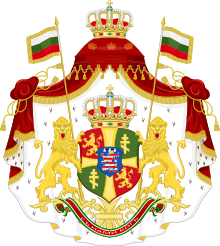
Fürst Alexander von Bulgarien führte als Sohn des Prinzen Alexander von Hessen-Darmstadt aus nicht ebenbürtiger Ehe (Haus Battenberg) den hessischen Löwen mit dem Turnierkragen in den battenbergischen Farben als Beizeichen.
Italien
Haus Savoyen
 |  |  |  |  |
| Wappen des Monarchen | Wappen des | Wappen des Herzogs von Genua | Wappen des Herzogs von Aosta | Wappen des Fürsten von Carignan[4][5] |
Portugal
Portugiesische Königsfamilie
 |  |  |  |  |  |
| Wappen des Monarchen | Wappen des Kronprinzen | Wappen des Fürsten von Beira (Ältester Sohn des Kronprinzen) | Wappen des Ersten Infanten | Wappen des Zweiten Infanten | Wappen des Dritten Infanten |
Spanien
Die genealogischen Beizeichen:[6]
| – | Turnierkragen | Mond | Stern | Merlette | Ring | Lilie |
| Erster Sohn | Zweiter Sohn | Dritter Sohn | Vierter Sohn | Fünfter Sohn | Sechster Sohn | Siebter Sohn |
Spanische Königsfamilie
 |  |
| Wappen des Monarchen | Wappen des Fürsten von Asturien |
Siehe auch
Literatur
- Meyers Konversationslexikon. 4. Auflage. Verlag des Bibliographischen Instituts, Leipzig / Wien, 1885–1892
- Beizeichen. In: Meyers Konversations-Lexikon. 4. Auflage. Band 2, Verlag des Bibliographischen Instituts, Leipzig/Wien 1885–1892, S. 631.
Weblinks
Einzelnachweise
- ↑ Vgl.: Konrad Fuchs, Heribert Raab: dtv-Wörterbuch zur Geschichte. Band 1: A–K (= dtv 3283). 6. Auflage. Deutscher Taschenbuch Verlag, München 1987, ISBN 3-423-03283-9, S. 83.
- ↑ a b Walter Leonhard: Das große Buch der Wappenkunst. Entwicklung, Elemente, Bildmotive, Gestaltung. Georg D. W. Callway, München 1976, ISBN 3-7667-0335-8.
- ↑ Ottfried Neubecker, Roger Harmignies: Le Grand livre de l’héraldique. L’histoire, l’art et la science du blason. Bordas, Paris 1981, ISBN 2-04-012582-5.
- ↑ Heraldique Europeenne ( des vom 22. Februar 2011 im Internet Archive) Info: Der Archivlink wurde automatisch eingesetzt und noch nicht geprüft. Bitte prüfe Original- und Archivlink gemäß Anleitung und entferne dann diesen Hinweis. Accessed 18. April 2009.
- ↑ Jiří Louda, Michael Maclagan: Les Dynasties d’Europe. Héraldique et Généalogie des Familles Impériales et Royales. Nouvelle édition. Bordas, Paris 1993, ISBN 2-04-027013-2, S. 242–243.
- ↑ José de Avilés, Marqués de Avilés: Ciencia heroyca, reducida a las leyes heráldicas del blasón. Band 2. J. Ibarra, Madrid 1780, S. 234–242 (Edición facsimilar: Bitácora, San Fernando de Henares 1992, ISBN 84-465-0006-X).
Auf dieser Seite verwendete Medien
Autor/Urheber: Die Autorenschaft wurde nicht in einer maschinell lesbaren Form angegeben. Es wird Jsobral als Autor angenommen (basierend auf den Rechteinhaber-Angaben)., Lizenz: CC BY 2.5
Arms of the third and next Infantes (male junior princes) of Portugal.
Made by JSobralAutor/Urheber:
- Coat_of_Arms_of_Edward,_Duke_of_Kent.svg: Sodacan
- derivative work: Sodacan (talk)
Coat of Arms of HRH Prince Edward, Duke of Kent. (born 1935) first son of Prince George, Duke of Kent (fourth son of King George V) and Princess Marina of Greece and Denmark. The coat of arms was granted in 1948.
| “ | Quarterly, 1st and 4th Gules three lions passant guardant in pale Or armed and langued Azure (for England), 2nd quarter Or a lion rampant within a double tressure flory-counter-flory Gules (for Scotland), 3rd quarter Azure a harp Or stringed Argent (for Ireland), with over all a label of five points Argent, the first, third and fifth points charged with a anchor Azure, and the second and fourth points with a cross Gules. | ” |
Autor/Urheber: Die Autorenschaft wurde nicht in einer maschinell lesbaren Form angegeben. Es wird Jsobral als Autor angenommen (basierend auf den Rechteinhaber-Angaben)., Lizenz: CC BY 2.5
Arms of the Second Infante (male junior prince) of Portugal.
Made by JSobralAutor/Urheber: , Lizenz: CC BY-SA 3.0
Coat of Arms of HRH Prince Andrew, Duke of York. (born 1960) second son of Queen Elizabeth II and Prince Philip the Duke of Edinburgh. The coat of arms was granted in 1963. The label of three points, with the central point charged with an anchor; was previously borne by his grandfather King George VI ('Bertie', also named Duke of York) and King George V (also Duke of York).
| “ | Quarterly, 1st and 4th Gules three lions passant guardant in pale Or armed and langued Azure (for England), 2nd quarter Or a lion rampant within a double tressure flory-counter-flory Gules (for Scotland), 3rd quarter Azure a harp Or stringed Argent (for Ireland), with over all a label of three points Argent the central point charged with an Anchor Azure. | ” |
a modern French shield: proportion 7:8.
Autor/Urheber:
- Coat_of_Arms_of_Henry_of_Wales.svg: Sodacan
- derivative work: Sodacan (talk)
Coat of Arms of HRH Prince Harry of Wales. (born 1984) second son of Prince Charles, Prince of Wales and Lady Diana Spencer. The coat of arms was granted in September 2002, on his 18th birthday. The three small red ‘escallop’ or sea-shell on the label alludes to the arms of his mother and the Spencer family. [1]
| “ | Quarterly, 1st and 4th Gules three lions passant guardant in pale Or armed and langued Azure (for England), 2nd quarter Or a lion rampant within a double tressure flory-counter-flory Gules (for Scotland), 3rd quarter Azure a harp Or stringed Argent (for Ireland), with over all a label of three points Argent points charged with an Escallop Gules. | ” |
Autor/Urheber: Sodacan, Lizenz: CC BY-SA 3.0
Arms of the Kingdom of France (Moderne)
Autor/Urheber: Tomasz Steifer z Szadółek, Lizenz: CC BY 2.5
Differencing system in Scottish heraldry (English text); variations on basic coat of arms argent a fess sable.
Autor/Urheber:
- Coat_of_Arms_of_Beatrice_of_York.svg: Sodacan
- derivative work: Sodacan (talk)
Coat of Arms of HRH Princess Beatrice of York. (born 1988) first daughter of Prince Andrew, Duke of York and Sarah Ferguson, Duchess of York. The coat of arms was granted in July 2006, on her 18th birthday. The three small bees on the label alludes to the arms of her mother Sarah. The appearance of the bees thrice is also a canting (heraldic punning) on her name: Beatrice.
| “ | Quarterly, 1st and 4th Gules three lions passant guardant in pale Or armed and langued Azure (for England), 2nd quarter Or a lion rampant within a double tressure flory-counter-flory Gules (for Scotland), 3rd quarter Azure a harp Or stringed Argent (for Ireland), with over all a label of five points Argent the first, third and fifth points charged with a Bee volant proper. | ” |
Autor/Urheber: Die Autorenschaft wurde nicht in einer maschinell lesbaren Form angegeben. Es wird Jsobral als Autor angenommen (basierend auf den Rechteinhaber-Angaben)., Lizenz: CC BY 2.5
Small arms of the King of Portugal.
Made by JSobralAutor/Urheber: Diese Datei enthält Elemente, die von folgender Datei entnommen oder adaptiert wurden:, Lizenz: CC BY-SA 3.0
Coat of Arms of Spanish Monarch (Official).
Autor/Urheber: Sodacan, Lizenz: CC BY-SA 4.0
Arms of Catherine, Princess of Wales.svg
Autor/Urheber: Die Autorenschaft wurde nicht in einer maschinell lesbaren Form angegeben. Es wird Jsobral als Autor angenommen (basierend auf den Rechteinhaber-Angaben)., Lizenz: CC BY 2.5
Arms of the first infante (male junior prince) of Portugal
Made by JSobralAutor/Urheber:
- Coat_of_Arms_of_Michael_of_Kent.svg: Sodacan
- derivative work: Sodacan (talk)
Coat of Arms of HRH Prince Michael of Kent. (born 1942) second son of Prince George, Duke of Kent (fourth son of King George V) and Princess Marina of Greece and Denmark. The coat of arms was granted in 1962.
| “ | Quarterly, 1st and 4th Gules three lions passant guardant in pale Or armed and langued Azure (for England), 2nd quarter Or a lion rampant within a double tressure flory-counter-flory Gules (for Scotland), 3rd quarter Azure a harp Or stringed Argent (for Ireland), with over all a label of five points Argent, the first, third and fifth points bear a cross Gules, and the second and fourth points bear an anchor Azure. | ” |
Coat of arms of Ledenice market town, České Budějovice District, Czech Republic.
Blason moderne du duché du Berry : d'azur aux trois fleurs de lys d'or à la bordure engrelée de gueules
Blason du duché d'Orléans : d'azur aux trois fleurs de lys d'or au lambel d'argent
Autor/Urheber:
- derivative work: Fry1989
Shield of the coat of arms of the Genoa line of the House of Savoy.
Blason du duché d'Anjou : d'azur, à trois fleurs de lys d'or ; à la bordure de gueules
Autor/Urheber: User:Marnanel, Lizenz: CC BY-SA 3.0
English and Canadian cadency marks (brisures). Brisures in red.
Autor/Urheber:
- Coat_of_Arms_of_Richard,_Duke_of_Gloucester.svg: Sodacan
- derivative work: Sodacan (talk)
Coat of Arms of HRH Prince Richard, Duke of Gloucester. (born 1944) second son of Prince Henry, Duke of Gloucester (third son of King George V) and Alice Montagu Douglas Scott. The coat of arms was granted in 1962.
| “ | Quarterly, 1st and 4th Gules three lions passant guardant in pale Or armed and langued Azure (for England), 2nd quarter Or a lion rampant within a double tressure flory-counter-flory Gules (for Scotland), 3rd quarter Azure a harp Or stringed Argent (for Ireland), with over all a label of five points Argent, the centre and two outer points charged with a cross Gules, and the inner points with a lion passant guardant also of Gules. | ” |
Autor/Urheber:
- derivative work: Fry1989
Shield of the coat of arms of the Kingdom of Italy and of the Royal House of Savoy.
Autor/Urheber:
- Coat_of_Arms_of_the_Dauphin_of_France.svg: Sodacan
- derivative work: Sodacan (talk)
Coat of Arms of the Dauphin of France
Autor/Urheber: Carlodangio, Lizenz: CC BY-SA 4.0
Diese Datei enthält Elemente, die von folgender Datei entnommen oder adaptiert wurden:
Autor/Urheber: Die Autorenschaft wurde nicht in einer maschinell lesbaren Form angegeben. Es wird Jsobral als Autor angenommen (basierend auf den Rechteinhaber-Angaben)., Lizenz: CC BY 2.5
Arms of the Prince heir of Portugal.
Made by JSobralAutor/Urheber: Die Autorenschaft wurde nicht in einer maschinell lesbaren Form angegeben. Es wird Jsobral als Autor angenommen (basierend auf den Rechteinhaber-Angaben)., Lizenz: CC BY 2.5
Arms of the Portuguese Prince of Beira.
Made by JSobralAutor/Urheber:
- derivative work: Fry1989
Shield of the coat of arms of the Prince of Piedmont, Hereditary Prince of the House of Savoy and Kingdom of Italy.
Autor/Urheber:
- Coat_of_Arms_of_Edward,_Earl_of_Wessex.svg: Sodacan
- derivative work: Sodacan (talk)
Coat of Arms of HRH Prince Edward, Duke of Edinburgh. (born 1964) third son of Queen Elizabeth II and Prince Philip the Duke of Edinburgh. The coat of arms was granted in 1983.
| “ | Quarterly, 1st and 4th Gules three lions passant guardant in pale Or armed and langued Azure (for England), 2nd quarter Or a lion rampant within a double tressure flory-counter-flory Gules (for Scotland), 3rd quarter Azure a harp Or stringed Argent (for Ireland), with over all a label of three points Argent the central point charged with an Tudor rose. | ” |
Autor/Urheber: Proof, Lizenz: CC BY-SA 3.0
Arms of thecounts of Soissons of Savoy-Carignano family
Autor/Urheber:
- derivative work: Fry1989
Shield of the coat of arms of the Aosta line of the House of Savoy.
Autor/Urheber:
- Coat_of_Arms_of_Eugenie_of_York.svg: Sodacan
- derivative work: Sodacan (talk)
Coat of Arms of HRH Princess Eugenie of York. (born 1990) second daughter of Prince Andrew, Duke of York and Sarah Ferguson, Duchess of York. The coat of arms was granted in July 2008, on her 18th birthday. The three thistle heads on the label alludes to the arms of her mother Sarah.
| “ | Quarterly, 1st and 4th Gules three lions passant guardant in pale Or armed and langued Azure (for England), 2nd quarter Or a lion rampant within a double tressure flory-counter-flory Gules (for Scotland), 3rd quarter Azure a harp Or stringed Argent (for Ireland), with over all a label of five points Argent the first, third and fifth points charged with a Thistle head proper. | ” |
Autor/Urheber: Diese Datei enthält Elemente, die von folgender Datei entnommen oder adaptiert wurden:, Lizenz: CC BY-SA 4.0
Coat of arms of Leonor, Princess of Asturias, heiress to the Spanish throne
Autor/Urheber:
- Coat_of_arms_of_the_Prince_of_Wales.svg: Sodacan
- derivative work: Sodacan (talk)
Shield of arms of HRH Prince William, the Prince of Wales (born 1982) son of King Charles III and Diana, Princess of Wales. The coat of arms was granted in 2022 to him as the Heir-Apparent to the British and Commonwealth thrones.
| “ | Quarterly, 1st and 4th Gules three lions passant guardant in pale Or armed and langued Azure (for England), 2nd quarter Or a lion rampant within a double tressure flory-counter-flory Gules (for Scotland), 3rd quarter Azure a harp Or stringed Argent (for Ireland), with over all a label of three points Argent, and on an inescutcheon ensigned by the coronet of the heir-apparent, quarterly, Or and Gules four lions passant guardant counterchanged (for the Principality of Wales). | ” |
Autor/Urheber: Glasshouse using elements by Sodacan, Lizenz: CC BY-SA 4.0
Princely Achievement of Bulgaria 1880-1887





























